The path to the supersonic front-line bomber. Part of 7. Yak-28, major modifications and designs.
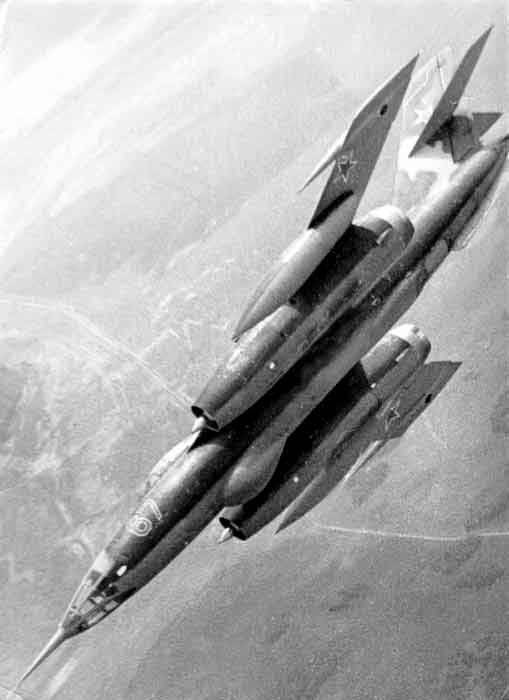
Almost all Yak-28B with outdated radar sight RBP-3 transferred to the customer for combat training. At the same time, the maximum speed within 1600 ... 1700 km / h, the practical ceiling 14 ... 15 km and the flight range without the suspended tanks 1550 km were guaranteed. As it is easy to see, according to all the main characteristics, the machine "did not reach" the requirements of the 5 decree of January 1959. But from the point of view of the Air Force, the incompliance with the modern requirements of the onboard instrument-navigation and sighting equipment turned out to be much more important. Thus, the OKB-115 fell into the "zugzwang" - it had a finished aircraft, launched into production, but the required "stuffing" for him was missing. There were two variants of “stuffing”: the radio range station “Lotos” (DBS-S) and the new autonomous airborne radar station “Initiative”.
The “initiative” was a completely perfect device, but it was extremely reliable. However, the "Lotos" required some refinement. The GKAT leadership found a way out: for some time the Irkutsk aircraft factory was loaded with the release of a simple training version of the Yak-28U, which lacked complex electronic devices. In the meantime, the development of the Yak-28L variant with the Lotus system hastily continued. The flight tests of the aircraft were carried out from 30 September 1960 on 14 in January 1961. Engineers Leonov and Yu.V. Petrov, pilots V.M. Volkov and V.G. Mukhin, navigator N.M. Shipovsky, and on state trials - engineers S.I. Blatov and A.I. Lobanov, pilots S.G. Grandfather, L.M. Kuvshinov and V.E. Hamsters. The main drawback of the car was the deteriorated view of the front hemisphere from the navigator’s cabin. Despite some remarks, the 27 of November 1961 was the Yak-28L aircraft adopted by the Air Force.
On the late-series Yak-28L aircraft, the power plant consisted of two P11AF2-300 turbojet engines 6100 kgf in the afterburner. Armament consisted of aerial bombs of caliber from 100 to 3000 kg. The Yak-28L was never officially accepted for service, and the release of this modification was limited to 111 copies.
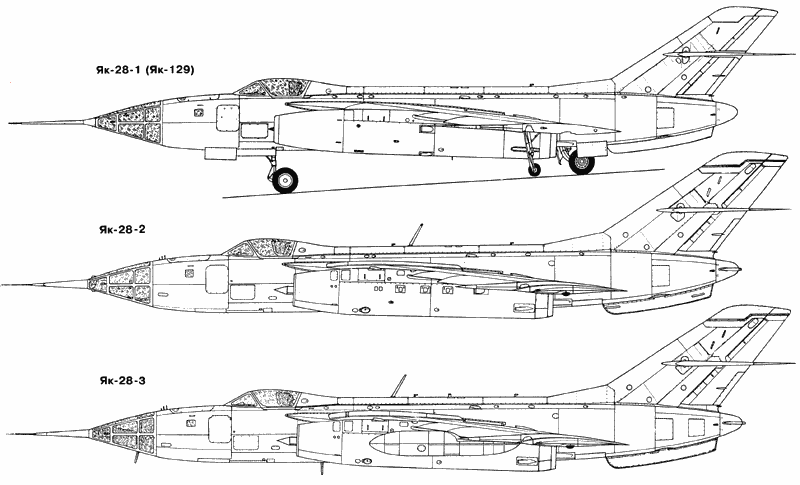
In 1960, one more modification of the bomber, the Yak-28I, came to factory tests. Factory tests were carried out by test pilots VM Volkov, VG Mukhin, navigator N. M. Shipovsky, leading engineers M. I. Leonov and R. S. Petrov. The aircraft was equipped with an integrated weapon control system consisting of: Initiative-2 radar, OPB-116 radar and AP-28K autopilot. In comparison with RPB-3, the new radar had a greater detection range and better resolution and, in general, was not inferior to the best world standards of that time. It is thanks to the good performance that this radar subsequently became one of the most common in the USSR and was used on 12 types of aircraft. The crew with its help could search and attack point moving targets at any time of the day and in adverse weather conditions. OPB-116 had a higher accuracy compared to OPB-115, increased viewing sector, better resolution and allowed to perform bombing from altitudes 2000-20000 m at flight speed 800-1700 km / h. Automatic data entry into the sight was provided from a height of 3500 m, and before that it was done only manually.
To accommodate the radar in the fuselage near the cockpit made an insert. On the test machine, the nose cone was re-glazed in a new way, which improved the view from the navigator’s cabin. To increase stability in flight, they increased the height of the ridges at the wing root. Initially, the prototype Yak-28I, like the experienced Yak-28L, was tested with the engines P-XNUMHAАF-11. In the process of finalizing the car equipped with P-300АФ11-2 in modernized gondolas, characterized by a circular cross-section of the inlet and elongated front part.
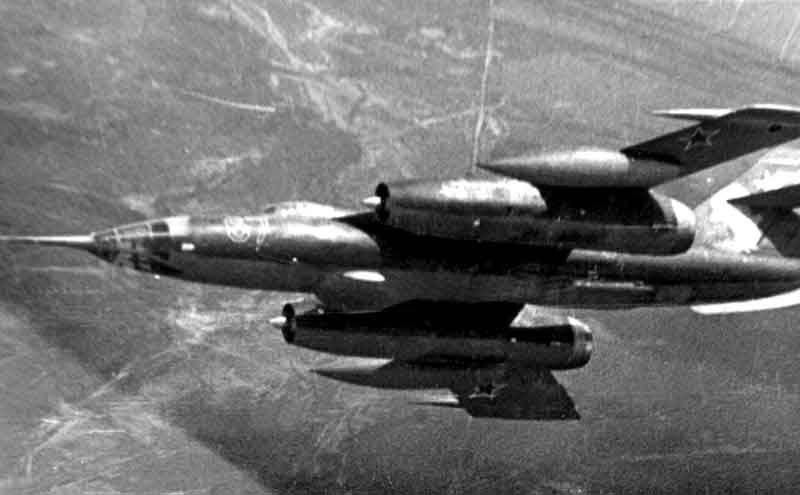
It was on this plane that the new power plant was tested. The problem of unstable operation of the compressor, characteristic of P-11F-300, was solved by refining the blades of the first stage. Elements of the anti-icing system of the new air intake worked on the Yak-25 flying laboratory. In the mass production of the Yak-28I launched even before the end of testing and refinement of the station "Initiative-2". When the operation of the aircraft in parts began, a significant deviation of the characteristics of the station from those recorded in the specifications was revealed. With the control bombings, the errors exceeded the normalized ones. Factory military representatives immediately ceased acceptance of the bombers. The ripening scandal forced Minister of Aviation Industry P.V. Dementieva to take extraordinary measures. Yakovlev with a large team, chief designers and specialists in the navigation complex, telescopic sight, radar, etc., as well as representatives of relevant research institutes were invited to the airfield where tests and refinement of the “Initiative” were conducted. In an effort to quickly understand the causes of the identified defects, work began with ground checks. When they gave nothing, flight experiments on a production aircraft were allowed. However, at this stage it was not possible to advance in research. It was necessary to equip the KZA bomber, to carry out a whole complex of flight research and development work, which stretched for almost a year and became essentially the first in the USSR serious research on the supersonic bombing system.
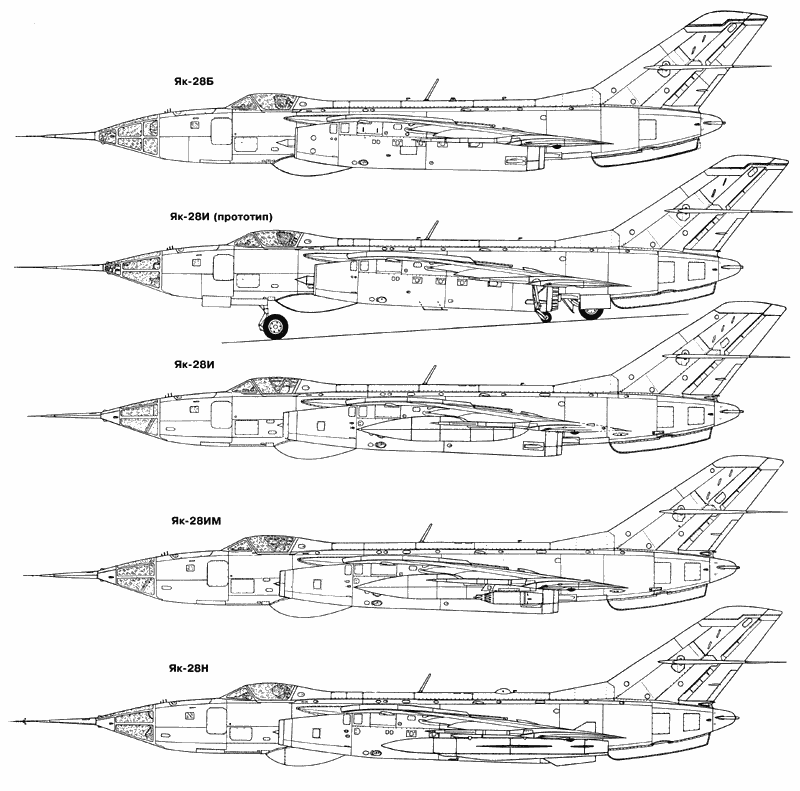
A significant contribution to the refinement of the Yak-28I bombing system was made by the employees of the Research Institute aviation systems (NIIAS). It was thanks to them that it was possible to find out that errors in determining the ballistic characteristics of bombs, measuring airspeed, instrumental errors of instruments, as well as disregard of external conditions when bombs leave the bomb bay, have a significant effect on accuracy. 1969 conducted special flight tests of the serial Yak-28I in order to study the possibility of bombing in the climb mode without modifying the sighting system. The tests were carried out at altitudes from 400 to 3200 m. From May 6 to June 18, 1970, the Yak-28L No. 3921204 was tested with a modified NR-23 gun mount (lead pilot Major I. Shirochenko). Earlier firing from a cannon in long bursts at high altitudes disrupted the operation of the power plant. Tests have shown that the modifications made made it possible to fire in bursts of up to 15-20 shots at altitudes of over 8000 m.
Tests of the aircraft with a view to its further improvement continued for many years. For example, from 20 March to 4 on April 1962, the State Research Institute of the Air Force held joint state tests of the Yak-28 serial bomber No.1900304 with the RPB-3 sight and improved takeoff and landing characteristics (in fact, it was the Yak-28B, but the documentation sometimes had an index "B" went down). Aircraft modifications were carried out in OKB-115 in order to reduce the run-up and run. In the rear part of the fuselage between the 34 and 37 frames, the attachment points of the two SPRD-118 accelerator powder accelerators were installed. In addition, instead of non-brake wheels, the front wheels of the landing gear were fitted with KT-82 brake wheels (they were placed on all production aircraft, starting with this number) and a brake parachute release machine was inserted. Unlike the Yak-28L, the fuel supply was reduced by 755 kg, and at maximum take-off mass - by 995 kg. The tests were conducted by test pilots GKNII Air Force Yu.M. Sukhov and VV Dobrovolsky. After their completion, the revisions were implemented in a series.
It was built 223 Yak-28I, which were officially adopted. And all in all, the combat units received about 350 percussion Yak-28 of various modifications.
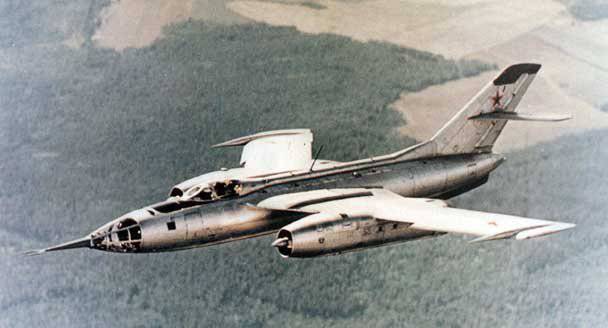
During the 1964-1965. in the Yak-115-based OKB-28, an aircraft carrier was designed for the K-28P weapon system, which included two X-28 anti-radar missiles and control equipment. In 1965, we completed the conceptual design, prepared the documentation and began the construction of a prototype Yak-28Н (carrier) by finalizing the serial Yak-28I. His factory tests began in the same year. Missiles were suspended on launching devices under the wing consoles. Radar detection equipment was located at the site of the Initiative radar. In addition to the suspension, the car externally differed antennas station guidance, attached to the gondola right engine. Despite the tests, the Yak-28H was not introduced into the series, but the X-28 itself subsequently found use in Su-17М2 fighter jets and Su-24 bombers.
From September to October, 1969 was conducted factory tests of the Yak-28IM, equipped with four underwing pylons for additional armament. A prototype machine was built by finalizing the serial Yak-28I No.4940503. Joint state tests of the bomber were carried out in 1973. By that time, the Su-17 and Su-24, equipped with a large assortment of weapons, were launched into high-volume production, and it was no longer necessary to continue the work to expand the combat capabilities of the Yak-28.
In general, over the years of production 111 Yak-28L and 223 Yak-28I were released. In general, it can be concluded that A.S. Yakovlev succeeded in adopting a machine, which did not fully satisfy the command of the Air Force in its qualities, although on the whole it met the world requirements of the time. For all the main flight data, the Yak-28 impact version on the 10 ... 15% did not reach the TTT target values, especially in terms of the flight range. To be fair, it should be noted that there really wasn’t a real alternative to the “twenty-eighth” in the front-bomber version. And over time, after the elimination of childhood diseases and obtaining a positive operating experience, the Air Force Commander-in-Chief took the side of OKB-115, seeking to expand the production of the Yak-28I, against which the USSR State Plan flatly objected.
At the end of the fifties and the beginning of the sixties of the last century, the Yakovlev Design Bureau developed several projects of combat aircraft, which were a development of the Yak-25 family - the Yak-28. The development of the Yak-32 aircraft was brought to a preliminary design signed by A.S. Yakovlev 25 May 1959 G. It was planned to install the engines VK-13 or AL-7Ф1. Flight weight: normal kg 23500, with kg hanging tanks 27000. The maximum speed of 2500 km / h, practical ceiling 21000 m, range 2600 km with the rest of the fuel 7%. It was this version of the car that aroused the greatest interest in the Air Force command, which appealed to A.S. Yakovlev and GKAT leadership with a proposal to design in the first place a front-line bomber with the data specified above, and later on to develop an intelligence officer at its base. Taught by bitter experience in fine-tuning radar bomber sights, the unreadiness of which prevented the adoption of the aircraft for use and caused conflicts with the Air Force, Yakovlev reacted without enthusiasm to the ideas of K.A. Vershinina. Full-scale development of the Yak-32 has not begun.
The next study of the OKB-115 was the Yak-34 reconnaissance bomber, whose speed was planned to increase to 3000 km / h, and the practical ceiling to 21000 ... 22000 m with a range of 3400 km (2200 km at 2500 km / h speed). Obviously, when moving to speeds of the order of 3000 km / h, a transition to new structural materials, steel and titanium, was required. A car with a close company at that time began to develop the Mikoyan OKB-155. Already, without much hope, in March, 1962 proposed. OKB-115 offered the Yak-34Р variant with Р21-300 engines (Р21А-300). The deadline for flight tests is the fourth quarter of 1965. But the development of the future MiG-25 has progressed with the competitors so far that the Yak-34Р project has remained unclaimed. At this OKB AS Yakovlev actually ceased attempts to create new front-line intelligence officers and bombers. The team faced new challenges associated with the development of vertical take-off and landing aircraft, as well as passenger cars.
To be continued.
The article used schemes from the site "Russian Force"
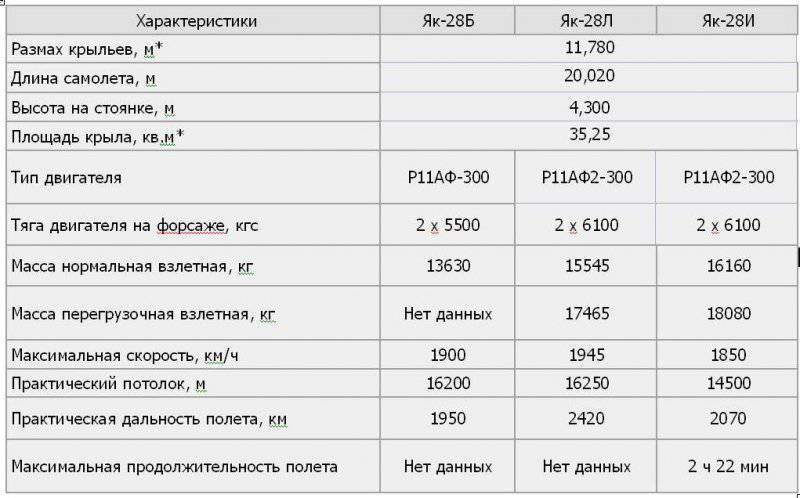
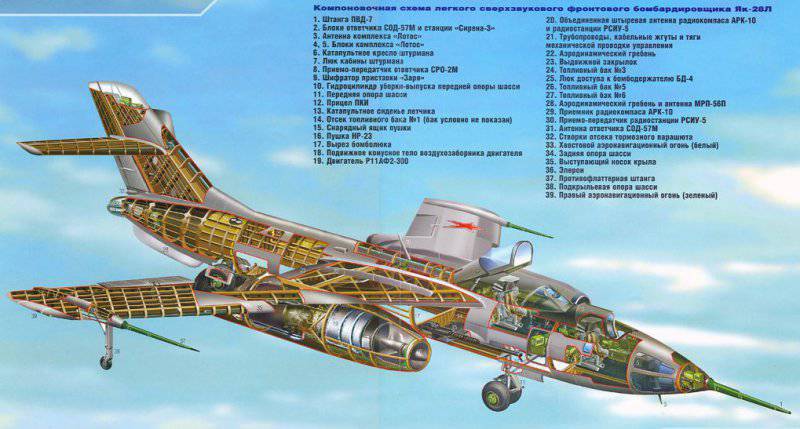
Information